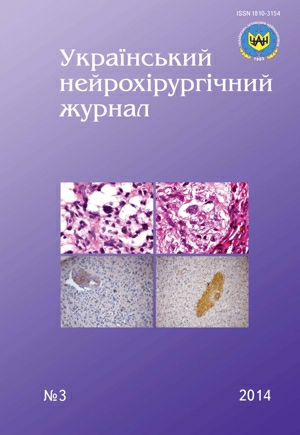The comparative assessment of efficacy of endoscopic transforaminal microdiscectomy and open microdiscectomy in treatment of lumbar discs herniation
DOI:
https://doi.org/10.25305/unj.47496Keywords:
lumbar spine, discs herniation, microsurgical discectomy, endoscopic transforaminal microdiscectomyAbstract
Introduction. Method of endoscopic transforaminal microdiscectomy (ETMDE) has it’s own supporters and opponents. We decided to compare efficacy of ETMDE and open microdiscectomy (MDE).
Materials and methods. We analyzed treatment results in two groups of patients, similar in age, disease duration, hernia localization and size, severity of pain and radiculopathy. In 60 patients (group 1) ETMDE was performed, in 60 (group 2) — MDE. the Short-term results were evaluated in the period from 1 to 30 days after surgery.
Results. Positive results were achieved in both groups, respectively, in 91.7 and 88.4% patients. However, early reoperations were performed significantly more often in group 1 — in 8.3% patients than in the group 2 — in 1.5%. In group 1 unsatisfactory results were due to hernias migration in cranial or caudal direction, in group 2 — due to hernias middle position. Rehabilitation terms after ETMDE was almost 3 times less than after MDE.
Conclusion. ETMDE technique with proper patients selection and adequate surgeon’s experience as effective as MDE. Worse outcomes were due to hernias migration in cranial or caudal direction, but rehabilitation terms in general, three times less than after MDE.
References
Zozulya Yua, Pedachenko EG, SLyn’ko Neirurgicheskoye lecheniye neyrokompressionnykh poyasnichno-kresttsovykh bolevykh sindromov [Surgical treatment of nuyrokompressive lumbosacral pain syndromes]. Kiev: UIPK EksOb; 2006. Russian.
Polischuk NYe, Slinko EI, Brinkach IS. [The surgical treatment assessment depending on the lower lumbar intervertebral disc hernias location]. Ukrainian Neurosurgical Journal. 2002;(4):82-90. Ukrainian.
Slin’ko EI, Verbov VV. [Ligament-sparing lumbar microdiscectomy. Results of clinical application of a technique]. Ukrainian Neurosurgical Journal. 2003;(1):54-62. Ukrainian.
Kambin P. Arthroscopic microdiscectomy. Baltimor: Urban A. Schwarzenberg; 1991.
Yeung AT, Savitz MH. Multilevel lumbar percutaneous endoscopic discectomy. J. Minim. Inv. Spin. Tech. 2001;12(1):116-119.
Iprenburg M, Godschalx A. Transforaminal endoscopic surgery in lumbar disc herniation in an economic crisis. — The TESSYS method. US Musculoskeletal Review. 2008;3:47-49.
Kim MJ, Lee HN, Jung ES, Son BG, Choi ES, Shin JH, Sung JK, Chi YC. Targeted percutaneous transforaminal endoscopic diskectomy in 295 patients: comparison with results of microscopic diskectomy. Surgical Neurology. 2007;68(6):623-631. [CrossRef] [PubMed]
Nellensteijn J, Ostelo R, Bartels R, Peul W, van Roven B, van Tulder M. Transforaminal endoscopic surgery for symptomatic lumbar disc herniations: a systematic review of the literature. Eur. Spine J. 2010;19(2):181-204. [CrossRef] [PubMed]
Jasper GP, Francisco GM, Telfeian AE. A retrospective evaluation of the clinical success of transforaminal endoscopic discectomy with foraminotomy in geriatric. Patients Pain Phys. 2013;16(3):225-229. [PubMed]
Morgenstein R. Transforaminal endoscopic stenosis surgery (TESS). In: Abstracts of 27 International Course for Percutaneous Endoscopic Spinal Surgery and Complementary Minimal Invasive Techiques. Karsruhe, 2009. p.117-121.
Schubert M, Helmbrecht A, Schultz C, Wagner C. Endoscopic transforaminal discectomy. In: Abstracts of 28 International Course for Percutaneous Endoscopic Spinal Surgery and Complementary Minimal Invasive Techiques. — Zurich, 2010. p.86-92.
Schubert M, Helmbrecht A, Schultz C, Wagner C. Endoscopic transforaminal discoplasty in disc degeneration and low back pain. In: ISASS13 Full Abstract Book. — Vancouver, 2013. p.191-201.
Hoogland T, van den Brekel-Dijkstra K, Schubert M, Miklitz B. Endoscopic transforaminal discectomyfor recurrent lumbar disc herniation. Spine. 2008;33(9):973-978. [CrossRef] [PubMed]
Downloads
Published
How to Cite
Issue
Section
License
Copyright (c) 2014 Mykola Zorin, Yuriy Kirpa, Mykola Zorin Jr

This work is licensed under a Creative Commons Attribution 4.0 International License.
Ukrainian Neurosurgical Journal abides by the CREATIVE COMMONS copyright rights and permissions for open access journals.
Authors, who are published in this Journal, agree to the following conditions:
1. The authors reserve the right to authorship of the work and pass the first publication right of this work to the Journal under the terms of Creative Commons Attribution License, which allows others to freely distribute the published research with the obligatory reference to the authors of the original work and the first publication of the work in this Journal.
2. The authors have the right to conclude separate supplement agreements that relate to non-exclusive work distribution in the form of which it has been published by the Journal (for example, to upload the work to the online storage of the Journal or publish it as part of a monograph), provided that the reference to the first publication of the work in this Journal is included.









